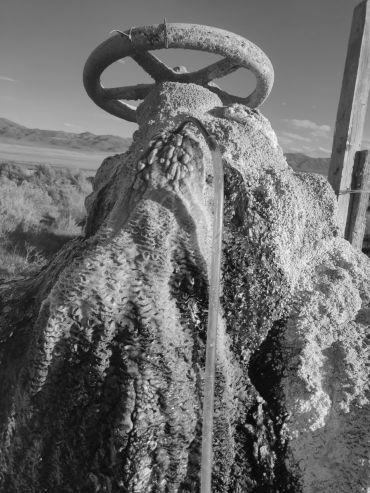In the modern world, a reliable supply of hydrogen gas is vital for the function of society. Fertiliser produced from hydrogen contributes to the food supply of half the global population, and hydrogen is also a key energy component in many roadmaps to a carbon neutral future, essential if we are to prevent the worst predictions of climate change.
Today, hydrogen is produced from hydrocarbons, with waste gases contributing to 2.4% of global CO2 emissions. Demand for hydrogen is set to increase from 90 million tonnes in 2022 to 540 million tonnes (and a $1000 billion market) in 2050, but it is vital that this hydrogen is not CO2 emitting. Production followed by the burial of waste CO2 (‘carbon sequestration’) or from renewable energy resources (wind or solar) are both future sources of hydrogen, but are not yet commercially competitive.
 Water well. Credit: Chris Ballentine, University of Oxford.
Water well. Credit: Chris Ballentine, University of Oxford.
New research from the University of Oxford, in collaboration with Durham University and the University of Toronto, provides a solution. In the last billion years, enough hydrogen gas has been produced by the Earth’s continental crust to supply mankind’s energy needs for at least 170,000 years. Whilst a proportion of this has been lost, consumed, or is inaccessible today, the remaining hydrogen could offer a natural (and emission-free) source of this natural resource.
Until now, limited historical hydrogen sampling and measurement have restricted scientists’ current understanding of where, and how much, hydrogen is located in the crust. An exploration recipe is critical to find accessible and commercially viable accumulations of natural geological hydrogen.
Study co-author Professor Jon Gluyas from Durham University, noted: ‘We have successfully developed an exploration strategy for helium and a similar ‘first principles’ approach can be taken for hydrogen.’
This research outlines the key ingredients needed to inform an exploration strategy to find different ‘hydrogen systems.’ This includes how much hydrogen is produced and the rock types and conditions these occur in, how the hydrogen migrates underground from these rocks, the conditions that allow a gas field to form, and the conditions that destroy the hydrogen.
Study co-author Professor Barbara Sherwood Lollar from the University of Toronto said: ‘We know for example that underground microbes readily feast on hydrogen. Avoiding environments that bring them into contact with the hydrogen is important in preserving hydrogen in economic accumulations.’
The authors outline where understanding of these ingredients is strong, and highlight areas that need more work – such as rock reaction efficiencies and how geological histories can bring the right rocks together with the water that reacts with it.
Some sources of hydrogen gas, such as from the Earth’s mantle, have fuelled much speculation and hyperbole – but this research shows that these are not viable sources. Instead, the authors showed that the ingredients for a complete hydrogen system can be found in a range of common geological settings within the crust. Some of these can be geologically quite young, forming hydrogen ‘recently’ (millions to tens of millions of years), others truly ancient (hundreds of millions of years old) – but critically are found globally.
Lead author Professor Chris Ballentine, from the Department of Earth Sciences at the University of Oxford said: ‘Combining the ingredients to find accumulated hydrogen in any of these settings can be likened to cooking a soufflé – get any one of the ingredients, amounts, timing, or temperature wrong and you will be disappointed. One successful exploration recipe that is repeatable will unlock a commercially competitive, low-carbon hydrogen source that would significantly contribute to the energy transition – we have the right experience to combine these ingredients and find that recipe.’
The potential for natural geological hydrogen has motivated the authors to form Snowfox Discovery Ltd., an exploration company with a mission to find societally significant natural hydrogen accumulations.
The review article ‘Natural hydrogen resource accumulation in the continental crust’ has been published in Nature Reviews Earth & Environment.
“The University of Oxford is a collegiate research university in Oxford, England. There is evidence of teaching as early as 1096, making it the oldest university in the English-speaking world and the world’s second-oldest university in continuous operation.”
Please visit the firm link to site



